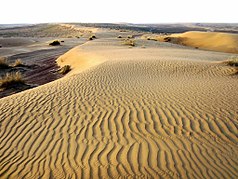Repetek Biosphere Reserve
| Repetek Biosphere Reserve | ||
|---|---|---|
| Postage stamp showing dromedaries in the Repetek Biosphere Reserve. | ||
|
|
||
| Location: | Turkmenistan | |
| Surface: | 34,600 ha | |
| Founding: | October 27, 1927 | |
| Dunes in the Karakum. | ||
The Repetek Biosphere Reserve is a 34,600 hectare biosphere reserve in Turkmenistan , which is located in the southeast of the Karakum Desert. It was first established as a research station in 1912 and then achieved the status of a nature reserve in 1927. It is 185-200 m above sea level . The name probably comes from Arabic (" Rubshatakh ") and translates as " narrow space with fresh water ". Its landscape is dry and characterized by moving sand dunes, also known as " barachans ". The area is one of the hottest in Asia . In the reserve, there are 21 trees, 104 grasses, one moss, 68 soil algae and 197 mushrooms of different species . It is characterized in particular by the fact that 4.5% of the area is covered by the black Saxaul . This is one of the reasons why it has been a UNESCO biosphere reserve since 1978 .
history
Until 1927
In the mid- 19th century, Russia built the railway line Krasnovodsk-Chardjou in the trans- Caspian region. However, the engineers faced the problem of drifting sand. So they asked the Russian Geographical Society for assistance. This followed the request and began in 1910 with the establishment of a commission to research drifting sand. This gave the recommendation to build a research station near the Repetek train station, which happened in the spring of 1912. From 1912 to 1918, meteorological investigations were carried out in the Karakum from there and methods for protecting railway lines from drifting sand were developed. In the second half of the 1920s , expeditions to the eastern Karakum were carried out to make botanical observations. On October 27, the area received the status of a nature reserve.
After 1927
After being designated a nature reserve for the purpose of researching and preserving the flora and fauna of the area, studies were initially carried out in the 1930s on the growth of agricultural plants in arid regions. In the 1950s, research was mainly focused on the planting and growth of trees, particularly at train stations and lines. It thus became the first desert reserve in the Soviet Union. At that time, about 34% of all species living there were endemic . From 1965 to 1974 the reserve took part in the International Biological Program and received the status of a UNESCO Biosphere Reserve in 1978. A nature museum was opened in 1972, which gave visitors the opportunity to see numerous animals and insects in the region. As a result, the reserve was very popular at that time and was visited by 5000 visitors and scientists (200 from abroad) annually. In addition, research into agriculture was resumed in the 1970s and studies were carried out on over 1500 plants.
Weather
|
Weather (1990)
Source:
|
|||||||||||||||||||||||||||||||||||||||||||||||||||||||||||||||||||||||||||||||||||||||||||||||||||||||||||||||||||||||||||||||||||||||||||||||||||||||||||||||||||||||||||||||||||||||||||||||||||
Flora and fauna
The flora and fauna that are native to the Repetek Biosphere Reserve have been the subject of numerous publications. As far as we know today, the area is home to around 1343 species, 7 of which are on the Red List .
The spiders living in the Repetek Biosphere Reserve are largely assigned to the so-called "Turanian Desert Species", which includes 58 species.
Individual evidence
- ^ William Seifriz: Sketches of the Vegetation of Some Southern Provinces of Soviet Russia: IV Autumnal Plants at Repetek, Turkmenistan . In: Journal of Ecology . tape 20 , no. 1 , February 1932, p. 69-77 .
- ↑ UNESCO World Heritage Center: Repetek Biosphere State Reserve. Retrieved July 9, 2019 .
- ↑ a b c J.V. Rakhmanov, SV Veyisov, VY Kuzmenko: The Repetek International Biosphere Reserve . In: Desert Problems and Desertification in Central Asia . Springer Berlin Heidelberg, Berlin, Heidelberg 1999, ISBN 978-3-642-64268-5 , pp. 247–255 , doi : 10.1007 / 978-3-642-60128-6_22 ( springer.com [accessed July 9, 2019]).
- ↑ AG Babaev: Anniversary of Repetek sandy-desert station. In: Probliemy osvoieniia pustyn. 1982, p. 3-7 .
- ↑ a b p Veyisov, VD Kuzmenko, O. Sopyev: Repetek international biosphere reserve . In: Probliemy osvoieniia pustyn . 1996, p. 25-30 .
- ↑ a b Repetek. The Beauty of the World./Academy of Sciences of Turkmenistan. Retrieved July 10, 2019 .
- ↑ AV Sobisevich, Valerian Snytko, Vera Savenkova: The role of biosphere reserves in environmental protection at the Soviet Union . In: GeoConference SGEM . tape 18 , no. 5.1 , 2018, p. 963-969 .
- ↑ VE Sokolov, PD Gunin: Gunin Repetek reserve - the first desert biosphere reserve in the USSR . In: Nature (Priroda) . No. 1 , 1979, p. 32-41 (Russian).
- ↑ Introduction of fodder crops in Karakum: Introduction of fodder crops in Karakum. Ashgabat 1984.
- ↑ Station Name: Repetek. NOAA, accessed July 9, 2019 .
- ↑ VD Kuzmenko, SV Veiisov: List of scientific publications on the Repetek sandy desert station and biosphere reserve, 1982-1991 . In: Probl. Osvoenya pustyn . 1992, p. 76-85 .
- ↑ Kirill G. Mikhailov, Victor Fet: Fauna and Zoogeography of Spiders (Aranei) of Turkmenistan . In: Biogeography and Ecology of Turkmenistan (= Monographiae Biologicae ). Springer Netherlands, Dordrecht 1994, ISBN 978-94-011-1116-4 , pp. 499-524 , doi : 10.1007 / 978-94-011-1116-4_30 .


